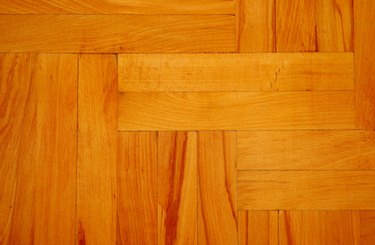
The term "floating floor" is usually used in reference to engineered hardwood flooring. The technical term is a tongue and groove system and requires no glue or nails to be held to the subfloor. Instead the wood planks "float" over the subfloor and either fit together like a puzzle or are glued. Once perfected, the system is generally reliable, though it does come with a few drawbacks.
Peaking
Video of the Day
Peaking is the result of engineered floors being pushed together too much. This pressure may result in the joints developing raised spots, which can occur for several reasons, though the most common is too little space between the flooring and walls or moldings, which prohibits space for normal expansion. Peaking can be treated by trimming the flooring that sits closest to the wall, giving more space for expansion. Once this has been done, weights can be placed at the peaked areas to flatten them out.
Video of the Day
Instability
Since floating floors are not stabilized or fastened to the subfloor, this may lead to a slight instability. Some consumers complain about the instability as a slight sagging or similar problem, and though it doesn't often result in any serious problems, it can be an irritation to homeowners. The majority of these problems come from either incorrect installation of the flooring or from purchasing low-quality or thin planks that may have a shorter life span than other types. One option for avoiding this is to install a dense underlay between the hardwood and subfloor, which will remove stress and other problems from the flooring and ease this wobbly feeling.
Noise
Noise -- groans, creaking and tapping -- may also be a result of floating floors. Another side effect of poor quality planks or bad installation, these sounds are difficult to muffle. This problem can be made worse when the matting under the floor is not thick enough. Additional problems may come along as the floor flexes in hot or cold weather, a problem that doesn't usually occur with engineered wood but may be noticed if not installed properly. Too little glue at wood seams and moldings, or pieces that have been too tightly installed, may also cause these issues.
Warping
Most often caused by moisture and water damage, warping can make floors uneven and ultimately may be difficult and expensive to fix. The warping and buckling will force individual floor boards to curve up and down, making the floor more likely to develop a mold or mildew problem. Warping may be caused by regular humidity in the air, mopping with excessive water or an improperly installed moisture barrier between the flooring and the subfloor.